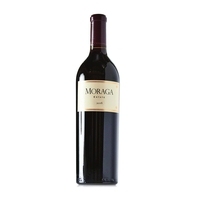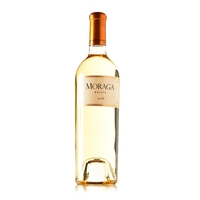California red wine selling for $150+ a bottle is not a rarity anymore. But who’s heard of a Los Angeles winery selling one for that price? For that matter, who’s heard of Los Angeles wineries at all? If you haven’t, you’re not alone. I asked two well-respected California-based wine writers if they had ever heard of this winery and was met with a deafening silence.
So, let me introduce you to Moraga Winery, located in the tony Bel Air section of Los Angeles. Visible from Interstate 405 and a quick 15 minutes from LAX, Moraga Bel Air sits in an upscale—to say the least—residential neighborhood overlooking the Pacific Ocean.
First, a little background.
Though California “Wine Country” today is centered north of San Francisco in Napa and Sonoma Counties, the original Wine Country was actually centered in Los Angeles. In 1836, a couple decades before Hungarian Agoston  Haraszthy imported European vines to Sonoma County, Frenchman Jean-Louis Vignes (what an appropriate name) brought French vines and planted them on the east bank of the Los Angeles River, in what is now downtown Los Angeles. There were over 100 wineries in Los Angeles County in the early 19th century, sending wine to the thirsty 49ers mining for gold up north. Los Angeles-based wineries never survived following prohibition, but Vine Street reminds us of the city’s wine legacy.
Haraszthy imported European vines to Sonoma County, Frenchman Jean-Louis Vignes (what an appropriate name) brought French vines and planted them on the east bank of the Los Angeles River, in what is now downtown Los Angeles. There were over 100 wineries in Los Angeles County in the early 19th century, sending wine to the thirsty 49ers mining for gold up north. Los Angeles-based wineries never survived following prohibition, but Vine Street reminds us of the city’s wine legacy.
Fast forward to 1959, when Tom Jones, CEO of Northrup Aviation, and his wife, Ruth, purchased this jewel of a property located on the edge of the Santa Monica Mountains that had been owned by famed film director Victor Fleming, who won an Oscar for Gone with the Wind. In 1980, Jones started planting vines and after several experiments, finally settled on Bordeaux varieties. Though their first commercial vintage was 1989, it wasn’t until 2005 when they built a winery that they established themselves as an estate winery—meaning they use only their own grapes and vinify them on-site. Prior to 2005, the wine was made entirely from their grapes, but in a Napa Valley winery.
In 2013, media mogul Rupert Murdoch, whose News Corp owns, among others, Fox News and Dow Jones Company, which publishes The Wall Street Journal, purchased the 14-acre estate, which includes an 8,000 square foot house, gardens, winery and vineyards, for $28.8 million.
Currently, Moraga Bel Air has just under 7 acres of vines, planted to Cabernet Sauvignon (4.3 acres), Merlot, Sauvignon Blanc (each 1.2 acres), Cabernet Franc and Petit Verdot (each 0.1 acre). They make two wines, a red and a white, simply labeled as such with a California appellation. Scott Rich, the  winemaker who has been with them since the mid-1990s, explains that the composition of the red wine usually contains more than 75 percent of Cabernet Sauvignon and could be labeled as such, but since the blend varies each year depending on how each of the individual varieties do, they don’t want to constrain themselves with varietal labeling. Though the white is always 100 percent Sauvignon Blanc, they still label it simply as white wine, to keep the labeling consistent. Rich explains that since Moraga Bel Air does not sit within a recognized AVA, they had the option of either using the county or state appellation. They opted for California over Los Angeles County, since consumers might not take a wine from Los Angeles seriously. Hint, they should.
winemaker who has been with them since the mid-1990s, explains that the composition of the red wine usually contains more than 75 percent of Cabernet Sauvignon and could be labeled as such, but since the blend varies each year depending on how each of the individual varieties do, they don’t want to constrain themselves with varietal labeling. Though the white is always 100 percent Sauvignon Blanc, they still label it simply as white wine, to keep the labeling consistent. Rich explains that since Moraga Bel Air does not sit within a recognized AVA, they had the option of either using the county or state appellation. They opted for California over Los Angeles County, since consumers might not take a wine from Los Angeles seriously. Hint, they should.
Rich emphasizes that their site is unique. Just five miles from the ocean, the soil and bedrock of this section of the mountains is uplifted seabed and marine in composition, specifically known as Santa Monica shale. He notes it is not limestone, but rather a limestone precursor. Additionally, situated on a fault line, the vineyard is very well drained. Located at the mouth of a canyon that faces Santa Monica Bay, the vines benefit from consistent afternoon sea breezes that keep the vineyards much cooler compared to the surrounding area. Rich remarks that prior to 2018, a very hot year, temperatures rarely exceeded 100ºF at their vineyard whereas just a few miles away triple digit temperatures were common during each the summer.
It took a lot of work and experimentation—and money—to get Moraga where it is today. Early on, Rich recounts how they opted to declassify and not bottle half of the wine because it failed to meet their standards. The learning-curve was steep. They wound up replanting extensively as they learned what grew  best where. They discovered that the conventional wisdom of planting Cabernet Sauvignon in south-facing vineyards, which should be warmer and better suited for that variety, didn’t work because that slope was too cold as a result of the cooling Pacific breezes. North-facing sites made horrible Sauvignon Blanc, according to Rich, because they were too hot for that grape. So, they converted those vineyards to Cabernet Sauvignon, which thrived in the warmer site. They even had to remove areas that had been carefully terraced previously when it turned out that that was not the best system for vines.
best where. They discovered that the conventional wisdom of planting Cabernet Sauvignon in south-facing vineyards, which should be warmer and better suited for that variety, didn’t work because that slope was too cold as a result of the cooling Pacific breezes. North-facing sites made horrible Sauvignon Blanc, according to Rich, because they were too hot for that grape. So, they converted those vineyards to Cabernet Sauvignon, which thrived in the warmer site. They even had to remove areas that had been carefully terraced previously when it turned out that that was not the best system for vines.
Rich describes the winemaking of the white as “super simple.” The juice settles over-night. He racks it off the gross lees and adds a little sulfur and then, using only native yeast, ferments twenty percent of the juice in new  small French oak barrels where it remains for only a few weeks. He ferments and ages the remainder in stainless steel tanks and blends the two batches before bottling. They produce roughly 300 cases a year. The wine retails for $115 a bottle.
small French oak barrels where it remains for only a few weeks. He ferments and ages the remainder in stainless steel tanks and blends the two batches before bottling. They produce roughly 300 cases a year. The wine retails for $115 a bottle.
Rich’s decision to age the red wine entirely in new, small, French oak barrels was serendipitous. Reluctant to age the wine in used barrels for fear of introducing organisms not indigenous to their estate, Rich opted to age the initial vintage entirely in new French oak barrels. The wine turned out just fine, according to him, and he has continued the practice ever since. The variable, depending on the vintage, is the length of time the wine spends in barrel, anywhere from 18 to 22 months.
Moraga’s 2016 Red Wine (91 pts, $175), a blend of Cabernet Sauvignon (78 percent), Merlot (21 percent), with the remaining one percent split between Cabernet Franc and Petit Verdot, is, like the Bel Air neighborhood, plush and suave. Nicely balanced, it delivers both spice and a plethora of fruit flavors enrobed in silky tannins. Most importantly, the wine is not overdone. You feel the effect of oak aging without it intruding. Its 14.7 percent stated alcohol is noticeable only by a hint of heat in the finish. Bright acidity keeps this refined wine lively.
Moraga’s production of red wine has been variable, between 200 and 700 cases, because of yields and overall quality. Rich relates how he thinks they should be producing between 600 and 700 cases of the red a year, “as long as Mother Nature cooperates.”
Here’s hoping She does.
E-mail me at [email protected] if you’ve ever heard of Moraga and follow me on Twitter @MichaelApstein and on Instagram.
July 22, 2020
